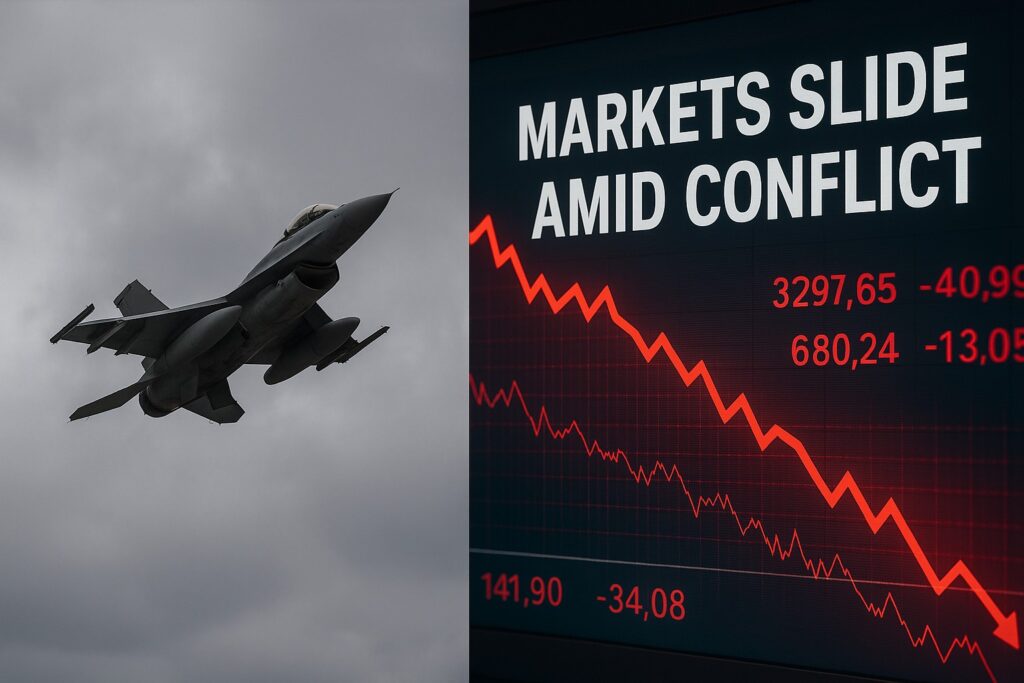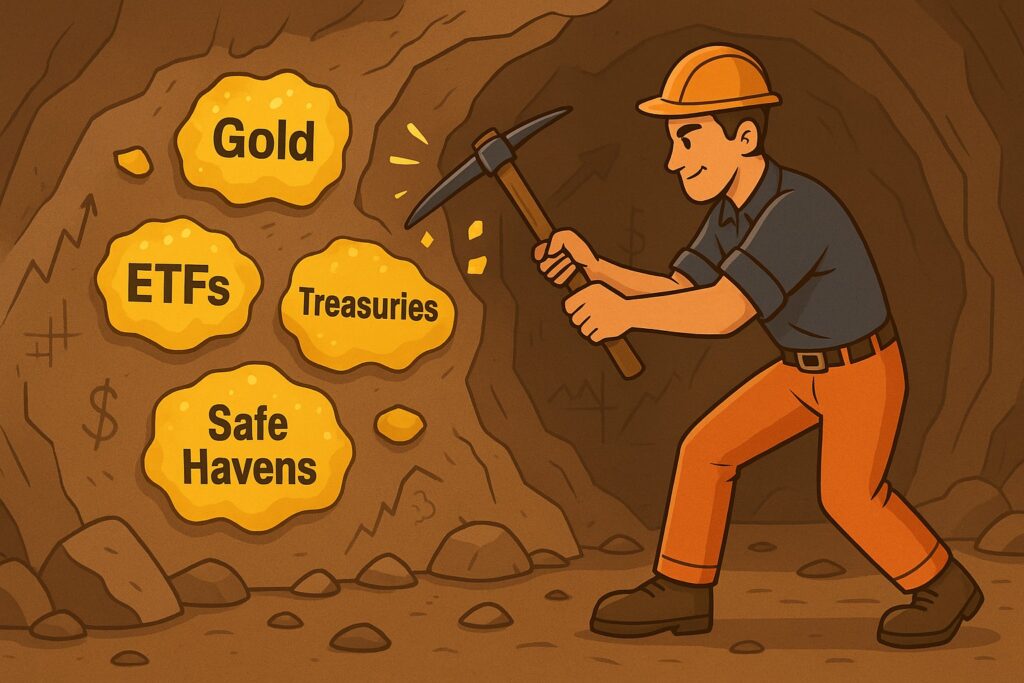Investing During Conflict: History, Strategy, and What to Do Now

You wake up, scroll through social media, and see Israel and Iran trending. There’s footage of missile strikes and oil-field fires. Stock futures are flashing red, feeds are full of panic, and the question hits you: What do I do with my portfolio? Should I sell and buy golden bricks or just run for the hills?
Buying gold might be smart but don’t head for the hills. Historically, the market’s first reaction to war is panic. But when the dust settles and the uncertainty narrows, markets often bounce back sometimes quicker than you’d expect.
Markets hate uncertainty more than war
We’ve seen this play out before, let’s take a look at how markets reacted during previous conflicts:
- 9/11 (2001): Markets closed for four days. When they reopened, the S&P 500 dropped -11.6% in five sessions. Airlines tanked nearly -40%. But by mid-November, the S&P had fully recovered.
- Gulf War (1990–91): Oil spiked from $22 to $40. The S&P fell 15% during the buildup but once the campaign began, stocks rallied 17% in four months.
- Iraq Invasion (2003): Uncertainty dragged the S&P down 14% from December to March. The day after the invasion started, markets actually rallied 2.3%, and were up over 15% by month’s end.
What can we take away from this? Markets hate uncertainty more than war. Once investors can size up the conflict’s scope and impact, they begin putting their money back to work.
Wartime Winners & Losers
| Category | Winners | Losers |
|---|---|---|
| Defense | Lockheed Martin (LMT), Raytheon (RTX) | – |
| Energy | ExxonMobil (XOM), Chevron (CVX) | Airlines, Cruise Lines |
| Consumer Staples | Procter & Gamble (PG), Costco (COST) | Luxury Brands, Retail (e.g., Tapestry, LVMH) |
| Commodities | Gold (GLD), Oil ETFs (XLE, OIH) | – |
| Volatility Plays | VIXY, VXX (short-term trades only) | – |
So how do different sectors respond when conflict hits? History shows investors shift money into stocks tied to national security and essential goods and pull out of anything linked to luxury, travel, or economic fragility.
For example, during the first month of Russia’s 2022 invasion of Ukraine, defense giant Lockheed Martin outperformed the S&P 500 by more than 15 percentage points. Meanwhile, European airline stocks lost a third of their value.
Here’s the pattern we’ve seen time after time:
- Defense stocks rally as governments ramp up military spending.
- Energy companies benefit from rising oil prices and supply concerns.
- Consumer staples (soap, food, household goods) stay resilient.
- Travel, tourism, and luxury companies often suffer steep losses.
The money doesn’t disappear it just moves toward safety. You don’t need to overhaul your portfolio, but it’s worth knowing where capital tends to flow when headlines turn red.
Smart Moves to Protect (and Grow) Your Portfolio

Knowing how markets react is one thing, knowing how to position yourself is another. Let’s talk about some practical moves you can make. Both safe haven plays and tactical opportunities, depending on your risk tolerance.
Safe-Haven Anchors
These assets tend to hold up or even rally when uncertainty hits.
- Gold (GLD): A classic hedge. It rose +15% in the early months of the Gulf War and recently hit an all-time high around $3,500/oz. I love gold, its been the best investment this year but beware of buying at the top. A pullback is likely if clarity returns.
- U.S. Treasuries (TLT): Treasuries are considered a global symbol of safety. As demand rises, prices go up and yields fall making them a reliable buffer.
- U.S. Dollar (UUP): In most crises, the dollar strengthens as capital flees riskier currencies. America’s reserve status makes it a parking spot even if some investors worry about long-term credibility under Trump era volatility and tariff threats.
These are your portfolio’s shock absorbers. They may not make you rich but they help you sleep better at night
Tactical Movers
For more active traders, there are also short-term opportunities:
- Energy ETFs (XLE, OIH): When oil spikes, these ETFs can rise fast. But gains tend to fade once supply fears ease, don’t chase just because oil is “hot.”
- Volatility ETFs (VIXY): When fear and uncertantity rise volatility ETFs can quickly surge but can also crash just as fast. Use only if you know how to manage short term trades with tight stop-losses and clear profit targets.
If you’re trading volatility, think like a sniper, not a cowboy. Your goal is to catch the fear spike not ride it into the ground.
The Data Favors Patience
If you take nothing else away from this article, remember this:
Every war time sell off since WWII has created an opportunity to buy great companies at a discount.
That’s what we believe at StockSavvyDad. We’re long-term, buy and hold investors first and that mindset wins more often than it loses.
Look at what just happened with Nvidia. During the tariff-driven panic this spring, it dropped to around $90 (post-split). Today, it’s back near $145. That’s a huge rebound in just a few months if you kept your cool and bought the dip.
Stay patient. Know your target prices. And when great stocks fall because of fear not fundamentals act on it and pull the trigger.
Smarter Investing Starts with Better Prompts
One of the best ways to stay on top of things and strategize during volatile times is to use AI. Here are 5 prompts you can use with ChatGPT to get fast, focused investment research when the world feels chaotic:
- “Act as a financial analyst. Summarize how the S&P 500, Dow, and NASDAQ have historically performed during times of war or geopolitical conflict like 9/11 or the Iraq invasion.”
- “List 3–5 U.S. stocks or ETFs that typically outperform during wartime, and explain why.”
- Which sectors underperform during geopolitical crises? Give examples and context.”
- What are the most reliable hedges during geopolitical risk—gold, bonds, currencies—and why do they work?”
- “What are smart short-term and long-term strategies investors can consider during the current Israel–Iran conflict, based on historic economical performance(s)“?
Copy. Paste. Refine. That’s hours of research turned into minutes of data you can put into action right away!
Ready to put these prompts to work?
The more prepared you are, the less likely you are to make emotional decisions when the headlines heat up. Whether it’s war, tariffs, or market turbulence, having the right tools gives you an edge.
That’s why I put together a free guide to help you make smarter investing moves with ChatGPT step by step.
👇 Grab your copy below and start using AI to invest with confidence.